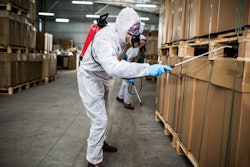
There is a constant state of evolution in the tech industry. No matter what product you purchase, you know it will be replaced by a newer version almost overnight. For a company to stay ahead of the competition and continue to meet the needs of its customers, there must be a progressive, visionary and fearless team in place.
Products and services are constantly being redesigned and improved to keep up with the wants and needs of the end-users. This creates excitement, or “buzz,” that surrounds the release of new products and services as customers anxiously await the next big thing.
Although the job of safety leaders is extremely important, the workplace safety arena does not generate much excitement with end users. Despite working to prevent pain, suffering and disability, there is rarely a “buzz” when new technology is released in the industry.
It is the role of a safety leader to generate that buzz.
There are two ways to bring excitement to the workers you protect. One is to use the variety of new safety technology options to inspire and engage workers and help to make their safety a personal issue.
The second is to embrace the progressive nature of technology and constantly improve the programs you offer based on feedback from them. By establishing workers as stakeholders, they recognize their influence on the safety of the entire company.
Especially in industries like warehousing and logistics where there is currently a shortage of frontline workers and extremely high rates of staff turnover, it is paramount to engage workers in their own safety. The labor market in this sector is competitive, and in order to get and keep good workers, you need an edge and be progressive in safety leadership.
Research shows that companies that actively involve their workers have a 43% lower staff turnover rate. Fostering a strong mental and emotional connection between workers and their job, team and organization will maximize performance and minimize turnover.
Choosing the right tech
There are seemingly endless choices within the industrial safety technology industry today. When choosing new, innovative products, it’s important to avoid “shiny object syndrome,” which can make short-lived solutions or gimmicks appear attractive.
The right product should add value while providing a real solution that enhances existing strategies. It must suit the safety needs and goals of the organization. The solution should be scalable with a clear deployment process that unblocks any adoption barriers, collecting quality data once in place.
The Journal of Human Factors and Ergonomics Society published a study in 2018 showing that approximately 80% of health and safety professionals would consider using wearable technology to help track and monitor risk factors at work. Workers’ acceptance on the other hand is paramount to whether the technology achieves its goals to keep people safe.
How to present technology to workers
The way technology is presented to employees makes a significant difference to product adoption. With frontline users, products must be easy to understand and make the workers feel like they are part of the solution right from the beginning. Workers should be able to quantify and manage their own risks while being able to measure the results.
Implement quality solutions and managing follow-up schedules to make sure changes, ideas and issues are promptly addressed, then revisit problems to ensure they have been resolved by asking employees for their feedback. Leaders can also make workers feel like part of the solution by recognizing safe performers and any ideas that improve safety.
Tech-savvy safety leadership requires an adaptive mindset. This means knowing how and when to balance innovation, risk and reward. Leaders must also be able to explain this to the executive business staff.
According to a study published by the Journal of Workplace Health and Safety, workplace safety is a shared responsibility between frontline staff managers and leadership within an organization, and a “speak-up culture” is encouraged to support safe work practices and prevent injuries from occurring.
It is also important to encourage collaboration and healthy debate. This can be accomplished by technology tools that provide personalized feedback empowering workers and putting them on equal footing with safety leaders and establishing collaborative teams to tackle personal safety issues.
UFA Co-operative released a study proving the positive results of implementing wearable technology.
Their results justified the program delivering an 86% reduction in ergonomic injuries, a 67% reduction in recordable workers' compensation claims and an 86% reduction in total ergonomic injury costs with an 11-time return on investment.
Employees can be more knowledgeable than the management staff when it comes to workplace safety and considering them to be your most trusted source of information will help keep the excitement up during any program implemented. These technologies generally integrate simple, streamlined ways for feedback to reach management to ensure they are heard and then efficiently actioned.
Although it is difficult to create a “buzz” around the release of new workplace safety solutions, leaders can increase positive adoption by including the workers in the entire adoption process, giving them their own measurable safety goals and milestones.
Being a great, tech-savvy safety leader is about words and actions. It is about meaningful conversation, encouraging a speak-up culture with employees and collaborating with actionable feedback.



















